How to Fish Umbrella Rigs for Bass
They’re controversial, but umbrella rigs can undoubtedly catch a lot of bass
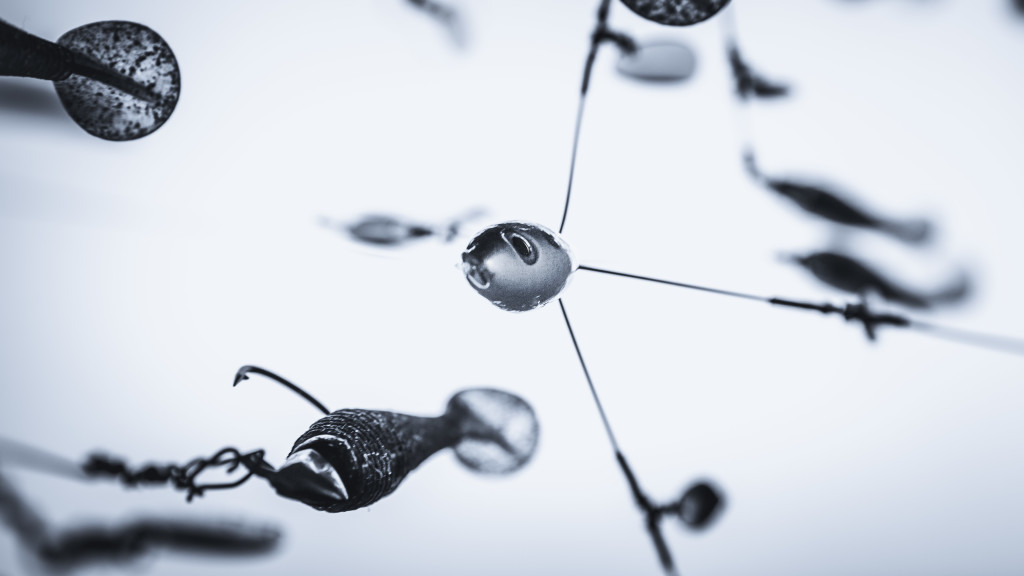
Castable umbrella rigs, also called Alabama rigs or A-rigs, were first deployed in tournament bass fishing by Paul Elias in the 2011 FLW Tour Open on Lake Guntersville. Since then, they’ve garnered a lot of controversy and caught a lot of bass.
Umbrella rigs essentially allow an angler to cast a school of baits on wire arms. Depending on how they’re arranged or weighted, you can fish an umbrella rig at a variety of depths and in a variety of situations. In the south, they get the most play in cool water months, but they’re good tools for smallmouths up north most of the year.
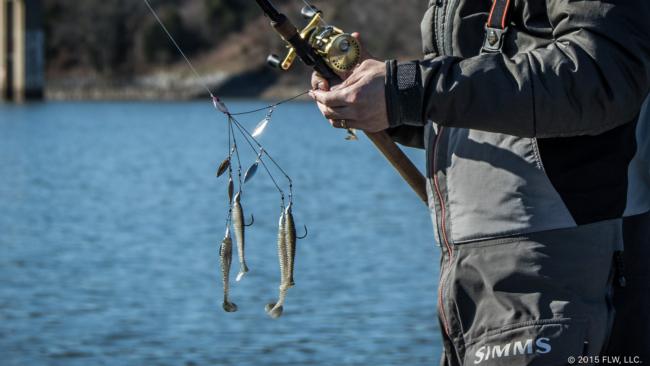
What is an umbrella rig
Most umbrella rigs are made with five wires emanating from a single point that is either built up to look fishy or simply a utilitarian connection point. The first umbrella rigs weren’t made with blades, but bladed versions are by far the most popular these days. Typically, rigs have four outer wires and one center wire that is a bit longer than the rest.
Some umbrella rigs come in very unusual configurations. There are models with extra-long arms that are bulked up to carry more than one bait, as well as models with extra arms to create rigs with up to nine baits. Additionally, many have more than one blade per arm.
Varying the length of the arms and the numbers of blades is one of the most common umbrella rig modifications. Because the number of baits and hooks that is legal varies by tournament and state, there is a lot of incentive to modify things. Often, rigs will be designed to carry extra “dummy” baits without hooks that keep the baits with hooks in prime position for the fish to eat.
When umbrella rigs first hit the bass fishing scene there was a tendency to use fairly large baits. Now, the most popular baits are usually 3- and 4-inch swimbaits on fairly light heads. Depending on the size of the baits and blades and the weight of the heads, an umbrella rig can be fished at a fairly broad range of depths – from right near the bottom to the upper half of the water column.
One constant on umbrella rigs is the importance of creating one or two baits that are targets for the bass to strike. Often, using a larger bait in the center is a key factor, or dying the tails or using a brighter color for certain baits. If you’re limited in the number of hooks you can use, you typically want the baits with hooks to be on the bottom and the back of the rig, not on the top.
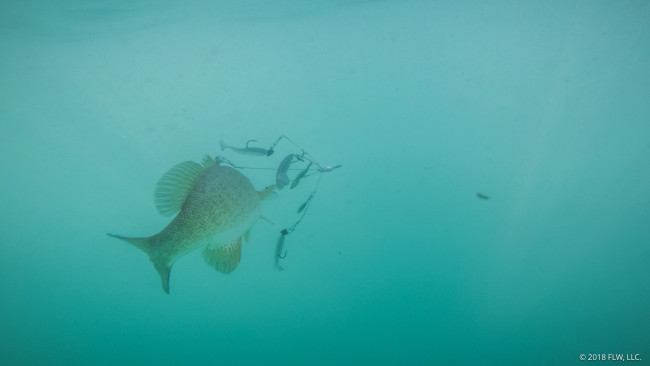
Umbrella rigs in action
You can retrieve an umbrella rig at any reasonable speed, and the whole package creates a schooling effect in the water. Depending on the baits you may have more or less action – a Keitech Swing Impact FAT swimbait will wiggle at the slowest speeds, but a Zoom Swimmer needs to be worked at a faster clip to really shine.
Most of the time a steady retrieve works well, but including a pop or two of the rod can be really clutch as well. Fish certainly like to follow umbrella rigs, and a little change up will often trigger them.
How to fish umbrella rigs
Simply casting and retrieving is often the name of the game with an umbrella rig. Figuring out where in the water column you want to fish it is the primary task. Sometimes when you’re fishing for truly suspended fish you want the rig high in the water. Other times — say, for smallmouths in the early winter — you want the rig to basically be crawling on the bottom.
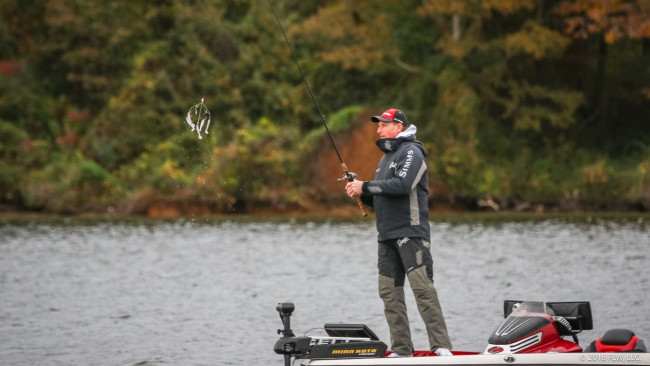
Where to fish umbrella rigs
Targeting areas with plentiful bait is a good rule of thumb for umbrella rigs, but one of the beautiful things about them is that they can be fished almost anywhere successfully. They aren’t good in heavy grass, obviously, but you can run an umbrella rig parallel to a dock, on a rip rap bank, around bridge pilings or out on a break in the main lake. Wherever bass live, these rigs can be successful.
Up north for smallmouths, umbrella rigs are very good around current, on flats with groups of smallmouths, and anywhere suspended bait is marked. In the south, some of the most popular targets are bluffs, bridges and steep banks.
Umbrella rigs are best used in water that is fairly clear. They certainly could catch fish in muddy water, but the clear waters of smallmouth haunts or the green-colored water of the Tennessee River have proven to be ideal scenarios more times than not.
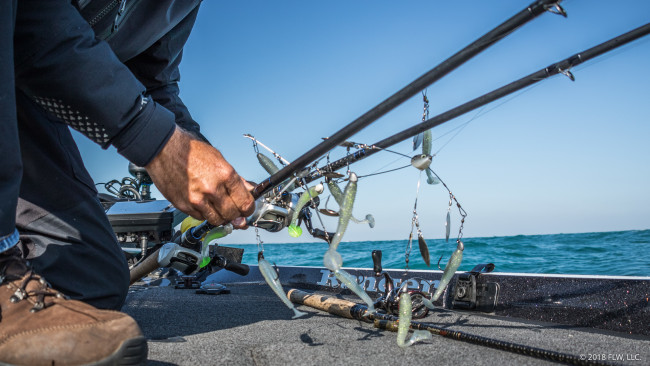
The best equipment for fishing umbrella rigs
Some pros throw umbrella rigs on really big rods – 8- or 9-foot long rods designed for big crankbaits or swimbaits. Others like rods that are more standard 7-foot models with a medium or heavy action. The main thing for your umbrella rig rod is to cast your chosen rig well. If you’re throwing a larger, heavier rig, you’ll want more rod. If you’re throwing a lighter rig you can get by with a lot less.
Braided line was the go-to when umbrella rigs first hit the scene, and it still has a place when you’re fishing the rig shallower or around grass, but fluorocarbon is the standard now. Typically, 16- or 20-pound-test will get the job done very well. It’s more forgiving than braid and less obtrusive in the water.
If you’re fishing a really big or heavy umbrella rig, a 300-size casting reel designed for heavy-duty use might be best, but a standard bass reel is just fine for most purposes. A 6:1 or 7:1 gear ratio will get the job done.
For baits, almost any swimbait will work, and small fluke-style baits can be good too. The best swimbait heads for umbrella rigs are usually light, around 1/8- or 1/16-ounce, but they should have a stout enough hook to match with the tackle you’re using. A truly finesse hook can easily bend out when paired with heavy fluorocarbon.
Rig recommendations
Strike King Tour Grade Titanium Umbrella Rig
Bait recommendations
Scottsboro Tackle Company Swimbaits
Jighead recommendations
6th Sense Core X Swimbait Jig Heads
Blade Runner Casting Rig Screw Lock Jig Head
Scottsboro Tackle Company Recon Swimbait Heads
Line recommendations
Berkley Trilene 100% Fluorocarbon
Rod recommendations
iRod Genesis II Light Flipping/Junk Rod
Team Lew’s Custom Pro Speed Stick Ledge Series Long Range Crankbaits rod
Reel recommendations
Abu Garcia REVO STX Gen 4 Casting Reel